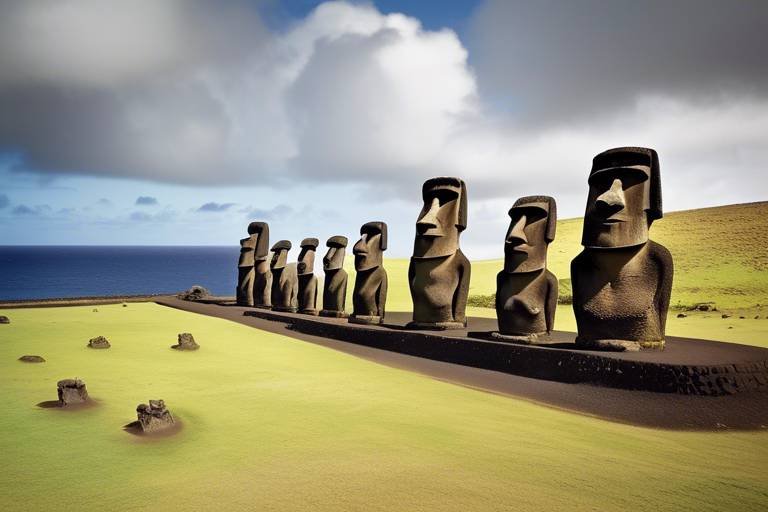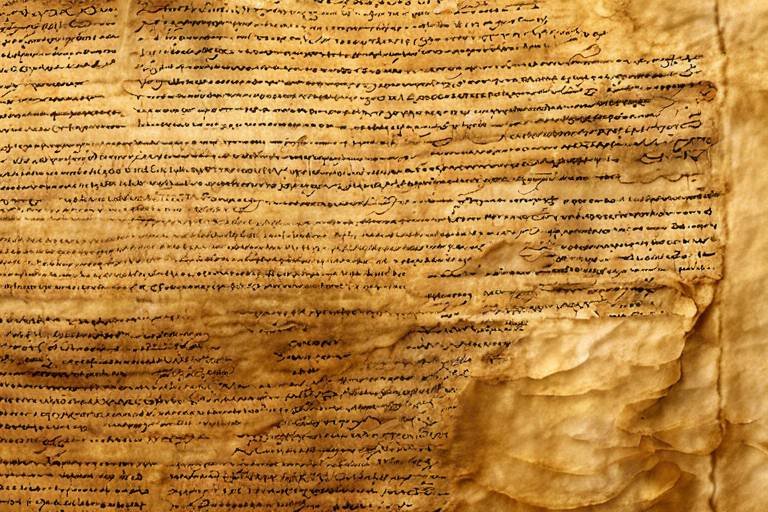The Mystery of the Ancient Mayan Astronomy
The ancient Mayan civilization has long fascinated historians, archaeologists, and astronomers alike with its profound knowledge and understanding of the cosmos. The mystery surrounding Mayan astronomy continues to captivate our imagination, offering a glimpse into a world where the stars, planets, and celestial events held immense significance in the daily lives of the Mayan people. Through their intricate astronomical observatories, sophisticated calendar systems, and remarkable predictions of eclipses, the Mayans left behind a legacy that continues to intrigue and inspire us today.

Mayan Civilization and Astronomy
The Mayan civilization, known for its advanced knowledge in various fields, had a deep connection with astronomy. The Mayans were skilled astronomers who used their understanding of celestial bodies for agricultural, religious, and societal purposes. Their intricate astronomical observations and calculations played a significant role in shaping their culture and daily lives.
The Mayans built impressive structures, such as observatories and temples, aligned with astronomical events like solstices and equinoxes. These architectural marvels served as a testament to their reverence for the cosmos and their desire to comprehend the mysteries of the universe.
Through their study of the stars, planets, and constellations, the Mayans developed complex calendar systems that accurately predicted celestial events. Their astronomical knowledge was not only practical but also intertwined with their spiritual beliefs and rituals, creating a holistic approach to understanding the cosmos.
Imagine standing in the shoes of a Mayan astronomer, gazing up at the night sky, deciphering the movements of celestial bodies, and unlocking the secrets of the universe. The Mayans' profound connection with astronomy transcended mere observation; it was a profound link between the earthly realm and the celestial realm, shaping their worldview and cultural identity.
As we delve deeper into the mysteries of Mayan astronomy, we begin to unravel the intricate tapestry of a civilization that saw the stars not just as distant lights but as guiding forces that influenced every aspect of their lives.

Mayan Astronomical Observatories
Within the fascinating realm of Mayan astronomy, the Mayan astronomical observatories stand as remarkable testaments to their advanced knowledge and understanding of celestial phenomena. These observatories were not merely structures; they were intricate hubs of scientific exploration, meticulously designed to track the movements of celestial bodies with astonishing precision.
The Mayan astronomers constructed their observatories in strategic locations, aligning them with key astronomical events such as solstices and equinoxes. These observatories were equipped with precise instruments and sighting devices, allowing the Mayans to observe and record the positions of stars, planets, and other celestial bodies with remarkable accuracy.
One of the most renowned Mayan astronomical observatories is the Caracol in Chichen Itza, which features narrow slits in its walls that align with specific celestial events. The Caracol's design demonstrates the Mayans' deep understanding of astronomy and their ability to predict celestial occurrences based on the movements of heavenly bodies.
Moreover, the Mayan astronomical observatories served not only as scientific research centers but also as sacred spaces where astronomical observations were intertwined with religious beliefs and rituals. The Mayans believed that the movements of celestial bodies were intricately connected to the divine and the spiritual realm, shaping their cosmological worldview.
In essence, the Mayan astronomical observatories symbolize the intersection of science, spirituality, and culture in the ancient Mayan civilization. These structures are not just architectural marvels but also windows into the profound intellectual and philosophical legacy of the Mayans, showcasing their profound connection to the cosmos.

Mayan Calendar Systems
Exploring the fascinating world of Mayan astronomy reveals a deep connection between the ancient Mayan civilization and their advanced knowledge of the cosmos. The Mayans, known for their intricate calendar systems and precise astronomical observations, used the stars and celestial bodies for various purposes that continue to intrigue and captivate modern-day researchers.
The Mayan calendar systems are a testament to the ingenuity and sophistication of Mayan civilization. Among the various calendar systems developed by the Mayans, two stand out for their complexity and significance: the Long Count and the Tzolk'in.
The Long Count calendar, based on a 260-day cycle, was used for tracking long periods of time and historical events. It provided a framework for recording dates and making predictions about the future. On the other hand, the Tzolk'in calendar, consisting of 260 days divided into 13-day cycles, was used for religious and ceremonial purposes, guiding rituals and activities based on its unique structure.
These calendar systems were not just tools for timekeeping; they were integral to Mayan society, influencing various aspects of life, from agriculture and governance to religious practices and social events. The intricate interplay between these calendars reflected the Mayans' deep understanding of the celestial rhythms and their belief in the interconnectedness of the physical and spiritual worlds.
Moreover, the Mayans' ability to synchronize multiple calendar systems and interpret celestial events with precision speaks volumes about their mathematical and astronomical prowess. By aligning their calendars with astronomical phenomena such as solstices, equinoxes, and planetary movements, the Mayans demonstrated a profound respect for the cosmos and a profound knowledge of the heavens.
In decoding the Mayan calendar systems, we not only unravel the intricate mechanisms of timekeeping and celestial reckoning but also gain insights into the cultural, spiritual, and scientific dimensions of the ancient Mayan civilization. The legacy of their calendar systems endures as a testament to human ingenuity and our enduring quest to understand the mysteries of the universe.
1. What were the main purposes of Mayan astronomical observations?
2. How did the Mayans use their calendar systems in everyday life?
3. What were some of the key astronomical achievements of the Mayans?
4. How did Mayan cosmological beliefs influence their understanding of the universe?
5. What is the significance of Mayan eclipse predictions in the study of ancient astronomy?
6. How have modern researchers decoded Mayan astronomical glyphs and symbols?
7. What lessons can we learn from the legacy of Mayan astronomy in our modern world?

Mayan Astronomical Achievements
The Mayan civilization is renowned for its remarkable astronomical achievements that continue to fascinate and intrigue researchers and historians to this day. The Mayans demonstrated an advanced understanding of celestial bodies and events, showcasing their profound knowledge of astronomy.
One of the most notable was their ability to accurately predict celestial events such as eclipses. Through meticulous observations and calculations, the Mayans developed a sophisticated system for forecasting solar and lunar eclipses, a feat that astounded many modern astronomers.
Furthermore, the Mayans' precise tracking of planetary movements and celestial cycles allowed them to create intricate calendars that aligned with astronomical phenomena. Their calendar systems, including the Long Count and Tzolk'in, reflected the Mayans' deep connection to the cosmos and their dedication to understanding the movements of the heavens.
Mayan astronomers also made significant contributions to the field of astrology, developing a comprehensive understanding of the stars, constellations, and celestial bodies. Their observations of the night sky led to the creation of elaborate starlore, myths, and legends that intertwined with their astronomical knowledge.
Through their astronomical achievements, the Mayans not only advanced their understanding of the universe but also integrated their cosmic knowledge into various aspects of their society. Astronomy played a crucial role in Mayan culture, influencing their religious beliefs, agricultural practices, and social organization.
In conclusion, the stand as a testament to the ingenuity and intellectual prowess of this ancient civilization. Their contributions to astronomy have left a lasting legacy that continues to inspire and captivate individuals around the world, shedding light on the sophisticated astronomical knowledge possessed by the Mayans.

Mayan Cosmology and Beliefs
The Mayan civilization had a rich tapestry of cosmological beliefs that intertwined with their advanced astronomical knowledge. To the Mayans, the cosmos was not just a vast expanse of stars and planets but a living entity intricately connected to their daily lives and rituals. Central to their beliefs was the concept of a cyclical universe, where time was viewed as a series of repeating cycles rather than a linear progression.
Mayan cosmology revolved around the idea that celestial bodies, such as the sun, moon, and planets, were divine entities with distinct personalities and purposes. They believed that these celestial beings influenced human affairs and events on Earth, shaping the course of history and guiding their actions. The movements of these celestial bodies were seen as a form of communication from the gods, providing guidance and warnings to the Mayan people.
Moreover, the Mayans believed in the existence of multiple layers of the cosmos, each inhabited by different deities and spirits. They saw the universe as a complex web of interconnected realms, where the actions of humans could impact the balance of the cosmic forces. Rituals and ceremonies were performed to honor and appease these celestial beings, ensuring harmony and prosperity in both the earthly and divine realms.
One of the most fascinating aspects of Mayan cosmology was their intricate calendar systems, which were deeply intertwined with their religious beliefs. The Long Count calendar, for example, was used to track long periods of time and cosmic cycles, while the Tzolk'in calendar governed their religious ceremonies and rituals. These calendars reflected the Mayan's profound understanding of the celestial movements and their belief in the cyclical nature of time.
Overall, the Mayan cosmological beliefs provided a spiritual framework for their astronomical observations and interpretations. By aligning their rituals and practices with the movements of the celestial bodies, the Mayans sought to maintain harmony with the cosmos and ensure the continuity of their civilization.

Mayan Starlore and Constellations
Embark on a journey through the mystical world of Mayan starlore and constellations, where the celestial realm intertwined with earthly beliefs to form a tapestry of cosmic significance. The Mayans, with their keen observational skills and profound connection to the cosmos, crafted intricate stories and myths around the stars above.
Imagine standing under the vast night sky, surrounded by the whispers of ancient tales woven into the twinkling lights above. The Mayans saw patterns in the stars and connected them to their everyday lives, creating a rich tapestry of celestial narratives that guided their rituals and beliefs.
One of the most famous Mayan constellations is the "Three Hearthstones" or "Three Stones," representing the hearthstones of creation according to Mayan mythology. These three stars were believed to symbolize the cosmic hearth where the gods first created the world.
Furthermore, the Mayans associated various animals and deities with specific constellations, attributing symbolic meanings and stories to each arrangement of stars. For example, the jaguar was a powerful symbol in Mayan culture and was often linked to celestial bodies, reflecting the intricate web of connections between the earthly realm and the heavens.
Through their starlore, the Mayans not only navigated the physical world but also delved into the spiritual and metaphysical realms, seeking guidance and wisdom from the celestial bodies above. Their deep understanding of the stars influenced every aspect of their lives, from agriculture to governance, creating a harmonious relationship between the earthly and divine.
As we gaze up at the night sky, let us ponder the intricate tapestry of stories and beliefs that the Mayans wove among the stars, reminding us of the timeless connection between humanity and the cosmos.

Mayan Eclipse Predictions
The Mayans possessed a remarkable ability to predict solar and lunar eclipses with astonishing accuracy, showcasing their deep understanding of celestial movements and cycles. Through their advanced astronomical knowledge, the Mayans developed sophisticated methods to anticipate these celestial events, which held great significance in their culture and society.
By meticulously observing the patterns of the sun and moon, the Mayans were able to create precise calendars that not only tracked time but also forecasted eclipses. Their predictions were crucial for religious ceremonies, agricultural planning, and societal organization, demonstrating the practical applications of their astronomical expertise.
One of the most intriguing aspects of Mayan eclipse predictions is the intricate correlation between celestial events and their religious beliefs. Eclipses were seen as cosmic messages from the gods, signaling important events or changes in the world. The Mayans believed that their rituals and offerings could influence the outcome of an eclipse, highlighting the spiritual connection they perceived between the heavens and Earth.
Through a combination of mathematical calculations, celestial observations, and symbolic interpretations, the Mayans were able to forecast eclipses with astonishing precision. Their ability to anticipate these rare astronomical phenomena reflects the depth of their astronomical knowledge and the sophistication of their civilization.
Deciphering the Mayan eclipse predictions not only sheds light on their scientific achievements but also provides insights into their cultural and spiritual beliefs. The legacy of Mayan astronomy, including their eclipse predictions, continues to fascinate and inspire modern astronomers, archaeologists, and historians, offering a glimpse into the enigmatic world of ancient Mesoamerican civilization.

Decoding Mayan Astronomical Glyphs
Deciphering the intricate glyphs and symbols used by the Mayans to record astronomical observations and calculations is like unraveling a cryptic puzzle that holds the secrets of their advanced knowledge. These glyphs, meticulously inscribed on stone monuments, codices, and pottery, provide a window into the sophisticated astronomical understanding of the Mayan civilization.
The Mayan astronomical glyphs are not mere symbols; they are intricate representations of celestial bodies, astronomical events, and mathematical calculations. Each glyph conveys a wealth of information, from the movements of planets to the cycles of the moon. Through these glyphs, the Mayans documented their observations of the heavens and encoded their astronomical wisdom for future generations to decipher.
One of the most fascinating aspects of decoding Mayan astronomical glyphs is the precision and detail with which the Mayans recorded celestial phenomena. Their glyphs not only depict astronomical events such as solstices, equinoxes, and planetary alignments but also contain mathematical calculations and symbolic representations of cosmic forces.
Furthermore, the Mayan glyphs often incorporate elements of their cosmological beliefs, intertwining astronomy with mythology and religion. By decoding these glyphs, researchers can gain insights into how the Mayans viewed the universe, the role of celestial bodies in their cosmology, and the significance of astronomical events in their cultural practices.
Deciphering Mayan astronomical glyphs requires a multidisciplinary approach, combining expertise in archaeology, astronomy, epigraphy, and mathematics. Scholars meticulously analyze the intricate details of each glyph, comparing them with known astronomical data and mathematical principles to unlock their meanings.
Through the decoding of Mayan astronomical glyphs, modern researchers have been able to reconstruct the Mayan calendar systems, understand their eclipse predictions, and appreciate the depth of their astronomical knowledge. Each glyph represents a piece of the puzzle, contributing to our understanding of the Mayan civilization's profound connection to the cosmos.
In conclusion, decoding Mayan astronomical glyphs is a journey of discovery that reveals the ingenuity, precision, and sophistication of the Mayan civilization in their exploration of the heavens. By unraveling these cryptic symbols, we gain a deeper appreciation for the enduring legacy of Mayan astronomy and the timeless wisdom encoded in their celestial observations.

Legacy of Mayan Astronomy
The legacy of Mayan astronomy continues to captivate and inspire modern scholars and astronomers alike. The Mayans' profound understanding of the cosmos and their sophisticated astronomical knowledge have left an indelible mark on history. Their astronomical achievements, including precise observations and predictions of celestial events, showcase their advanced intellect and ingenuity.
One of the most enduring legacies of Mayan astronomy is their intricate calendar systems, such as the Long Count and Tzolk'in. These calendars not only served practical purposes in organizing time and scheduling important events but also reflected the Mayans' deep connection to the celestial realm. The precision and complexity of these calendars demonstrate the Mayans' profound respect for the cycles of nature and the heavens.
Furthermore, the Mayans' cosmological beliefs and mythologies intertwined with their astronomical observations, shaping their understanding of the universe. Their intricate starlore and legends associated with celestial bodies and constellations provided a cultural and spiritual context to their astronomical pursuits. The Mayans saw the stars as divine entities guiding their lives and influencing their actions.
Deciphering the Mayan astronomical glyphs and symbols has been a challenging yet rewarding endeavor for researchers. These intricate inscriptions not only recorded astronomical observations but also encoded the Mayans' cosmological beliefs and knowledge. By decoding these glyphs, modern scholars have gained valuable insights into the Mayans' astronomical practices and worldview.
The enduring legacy of Mayan astronomy serves as a testament to the intellectual prowess and cultural richness of this ancient civilization. By studying and appreciating the achievements of the Mayans in the field of astronomy, we gain a deeper understanding of their society, beliefs, and connection to the cosmos. The legacy of Mayan astronomy reminds us of the timeless quest for knowledge and the enduring mysteries of the universe.
Frequently Asked Questions
- What is the significance of Mayan astronomy?
Mayan astronomy holds immense significance as it showcases the advanced knowledge and understanding of celestial events by the ancient Mayan civilization. Their astronomical observations and predictions not only influenced their societal activities but also reflected their deep connection to the cosmos.
- How did the Mayans use astronomical observatories?
The Mayans used sophisticated astronomical observatories to study and track celestial phenomena such as solstices, equinoxes, and planetary movements. These observatories were crucial in developing their precise calendar systems and making accurate astronomical predictions.
- What were the key calendar systems used by the Mayans?
The Mayans utilized intricate calendar systems, including the Long Count and Tzolk'in, to mark time and coordinate various activities. These calendars were not only practical tools but also held deep religious and cultural significance in Mayan society.
- How did the Mayans predict eclipses?
The Mayans had a remarkable ability to predict solar and lunar eclipses due to their detailed astronomical knowledge and precise observations. By understanding the patterns of celestial bodies, they could forecast eclipses with impressive accuracy.
- What is the legacy of Mayan astronomy?
The legacy of Mayan astronomy continues to inspire modern astronomers and researchers, shedding light on the intellectual and scientific achievements of ancient civilizations. It serves as a testament to the Mayans' profound understanding of the universe and their enduring impact on our understanding of astronomy.



















